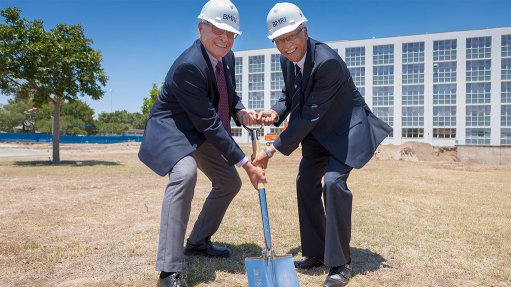
SU Vice-Chancellor Professor Wim de Villiers and Professor Jimmy Volmink at the sod-turning ceremony
Photo by: Terry February
Stellenbosch University (SU) has started construction on a Biomedical Research Institute (BMRI), to be based at the Faculty of Medicine and Health Sciences (FMHS).
The university believes the R1-billion facility, which will be completed in 2022, will be “one of the most innovative and advanced biomedical research centres in Africa”.
“The BMRI is set to significantly advance our capacity to undertake world-class research on the leading health problems affecting our people. It will also contribute considerably to building research capability in the African region,” says FMHS Dean Professor Jimmy Volmink.
The institute’s main aims will be to investigate diseases that have the greatest impact on communities in South Africa and the rest of Africa, and to translate its discoveries into improving the diagnosis, prevention and treatment of illnesses such as TB, HIV, diabetes, heart disease and neurological disorders, among others.
Biomedical teaching, training and research at the FMHS is currently based in its physiology and anatomy building, which was built in the 1970s.
In the four decades since the building has been opened, student numbers have more than tripled and the field of biomedicine has changed dramatically.
The new facility will allow for the immediate expansion of current research activities, as well as for the strengthening of research and teaching capacity in fields such as bioinformatics, genomics, anatomy, neurobiology, advanced surgical sciences, biobanking, and so forth.
Apart from a range of research laboratories, the new facility will also host a bioinformatics hub; electron microscopy laboratories; proteomics laboratories; morphology museum; biorepository; Sunskill laboratory; clinical research unit and conference facilities.
The BMRI facility will have a number of architectural features focused on sustainability, including a smart lighting system that detects areas where natural light is strongest and adjusts lighting accordingly, thus drawing less electricity from the grid.
The building will also tie into the campus’s grey water masterplan, which allows for rain water harvesting and the use of borehole water.
All toilets will be flushed with non-potable water.
A secure bicycle storage area with adjacent shower facilities will be located in the basement to encourage staff and students to cycle to work.
The BMRI will also have a system of negative air pressure that will keep hazardous fumes or airborne toxins from flowing out of laboratories and into adjacent areas.
The main contractor on the BMRI project is Wilson Bailey Holmes-Ovcon, with Glad Africa the principal agent and project manager. The architect is Roelof Rabe Argitekte.